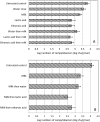A Method for the Preparation of Chicken Liver Pâté that Reliably Destroys Campylobacters
- PMID: 25927478
- PMCID: PMC4454932
- DOI: 10.3390/ijerph120504652
A Method for the Preparation of Chicken Liver Pâté that Reliably Destroys Campylobacters
Abstract
This study devised a protocol for the manufacture of commercial quantities of chicken liver pâté that reliably destroyed campylobacters. A literature search identified 40 pâté manufacture recipes. Recipes stages with a potential to be antimicrobial were assembled to form a new protocol that included washing with organic acid, freeze-thaw and flambé in alcohol. Naturally-contaminated, high-risk livers were obtained from clearance flocks at slaughter and the effect of each stage of the protocol on Campylobacter populations was determined. Organic acid washing changed the color of the liver surfaces. However, there were no significant differences between liver surface color changes when a range of concentrations of lactic acid and ethanoic acid washes were compared by reflective spectrophotometry. A 5% (w/v) acid wash reduced numbers of indigenous campylobacters by around 1.5 log₁₀ CFU/g for both acids. The use of a Bain Marie was found to more reproducibly apply heat compared with pan-frying. Antimicrobial recipe stages reduced the numbers of campylobacters, but not significantly if thermal processing was ineffective. Cooking to 63°C was confirmed to be a critical control point for campylobacters cooked in a Bain Marie. Organoleptic and sensory assessment of pâté determined an overall preference for pâté made from frozen livers.
Figures






Similar articles
-
Freezing as an intervention to reduce the numbers of campylobacters isolated from chicken livers.Lett Appl Microbiol. 2013 Sep;57(3):206-13. doi: 10.1111/lam.12098. Epub 2013 May 28. Lett Appl Microbiol. 2013. PMID: 23647008
-
Campylobacter spp. contamination of chicken carcasses during processing in relation to flock colonisation.Int J Food Microbiol. 2007 Jan 1;113(1):54-61. doi: 10.1016/j.ijfoodmicro.2006.07.011. Epub 2006 Sep 27. Int J Food Microbiol. 2007. PMID: 17007949
-
Campylobacter in chicken livers and their destruction by pan frying.Lett Appl Microbiol. 2006 Dec;43(6):591-5. doi: 10.1111/j.1472-765X.2006.02020.x. Lett Appl Microbiol. 2006. PMID: 17083702
-
Campylobacter infection of commercial poultry.Rev Sci Tech. 2000 Aug;19(2):376-95. doi: 10.20506/rst.19.2.1224. Rev Sci Tech. 2000. PMID: 10935269 Review.
-
Incidence and control of Campylobacter in foods.Microbiologia. 1993 Feb;9 Spec No:57-65. Microbiologia. 1993. PMID: 8484918 Review.
Cited by
-
Campylobacters and their bacteriophages from chicken liver: The prospect for phage biocontrol.Int J Food Microbiol. 2016 Nov 21;237:121-127. doi: 10.1016/j.ijfoodmicro.2016.08.026. Epub 2016 Aug 19. Int J Food Microbiol. 2016. PMID: 27565524 Free PMC article.
-
Impact of Eimeria tenella Coinfection on Campylobacter jejuni Colonization of the Chicken.Infect Immun. 2019 Jan 24;87(2):e00772-18. doi: 10.1128/IAI.00772-18. Print 2019 Feb. Infect Immun. 2019. PMID: 30510107 Free PMC article.
-
An assessment of the microbiological quality of liver-based pâté in England 2012-13: comparison of samples collected at retail and from catering businesses.Epidemiol Infect. 2017 Jun;145(8):1545-1556. doi: 10.1017/S0950268817000255. Epub 2017 Feb 13. Epidemiol Infect. 2017. PMID: 28190406 Free PMC article.
-
Chicken Liver-Associated Outbreaks of Campylobacteriosis and Salmonellosis, United States, 2000-2016: Identifying Opportunities for Prevention.Foodborne Pathog Dis. 2018 Nov;15(11):726-733. doi: 10.1089/fpd.2018.2489. Epub 2018 Sep 7. Foodborne Pathog Dis. 2018. PMID: 30192164 Free PMC article.
-
Detection of Campylobacter jejuni liver dissemination in experimentally colonized turkey poults.Poult Sci. 2020 Aug;99(8):4028-4033. doi: 10.1016/j.psj.2020.03.042. Epub 2020 May 7. Poult Sci. 2020. PMID: 32731990 Free PMC article.
References
-
- Wheeler J.G., Sethi D., Cowden J.M., Wall P.G., Tompkins D.S., Hudson M.J., Roderick P.J., The Infectious Intestinal Disease Executive Study of infectious intestinal disease in England: Rates in the community, presenting to general practice, and reported to national surveillance. Brit. Med. J. 1999;318 doi: 10.1136/bmj.318.7190.1046. - DOI - PMC - PubMed
Publication types
MeSH terms
LinkOut - more resources
Full Text Sources
Other Literature Sources
Medical

